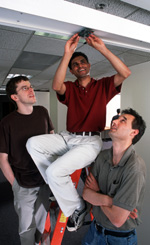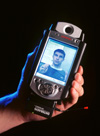Laboratory for Computer Science
The principal goal of the Laboratory for Computer Science (LCS) is to conduct research in all aspects of computer science and information technology, and to achieve societal impact with our research results. Founded in 1963 under the name Project MAC, it was renamed the Laboratory for Computer Science in 1974. Over the last four decades, LCS members and alumni have been instrumental in the development of many innovations, including time-shared computing, ARPANet, the internet, the ethernet, the world wide web, RSA public-key encryption, and many more.
As an interdepartmental laboratory in the School of Engineering, LCS brings together faculty, researchers, and students in a broad program of study, research, and experimentation. It is organized into 23 research groups, an administrative unit, and a computer service support unit. The laboratory's membership comprises a total of just over 500 people, including 106 faculty and research staff; 287 graduate students; 73 visitors, affiliates, and postdoctoral associates and fellows; and 35 support and administrative staff. The academic affiliation of most of the laboratory's faculty and students is with the Department of Electrical Engineering and Computer Science. Our research is sponsored by the US Government, primarily the Defense Advanced Research Projects Agency and the National Science Foundation, and many industrial sources, including NTT and the Oxygen Alliance. Since 1994, LCS has been the principal host of the World Wide Web Consortium (W3C) of nearly 500 organizations that helps set the standard of a continuously evolving world wide web.
The laboratory's current research falls into four principal categories: computer systems, theory of computation, human/computer interactions, and computer science and biology.
In the areas of computer systems, we wish to understand principles and develop technologies for the architecture and use of highly scaleable information infrastructures that interconnect human-operated and autonomous computers. This area encompasses research in networks, architecture, and software. Research in networks and systems increasingly addresses research issues in connection with mobile and context-aware networking, and the development of high-performance, practical software systems for parallel and distributed environments. We are creating architectural innovations by directly compiling applications onto programmable hardware, by providing software controlled architectures for low energy, through better cache management, and easier hardware design and verification. Software research is directed towards improving the performance, reliability, availability and security of computer software by improving the methods used to create such software.
In the area of the theory of computation, we study the theoretical underpinnings of computer science and information technology, including algorithms, cryptography and information security, complexity theory, distributed systems, and supercomputing technology. As a result, theoretical work permeates our research efforts in other areas. The laboratory expends a great deal of effort in theoretical computer science because its impact upon our world is expected to continue its past record of improving our understanding and pursuit of new frontiers with new models, concepts, methods, and algorithms.
In the human/computer interactions area, our technical goals are to understand and construct programs and machines that have greater and more useful sensory and cognitive capabilities so that they may communicate with people toward useful ends. The two principal areas of our focus are spoken dialogue systems between people and machines and graphics systems used predominantly for output. We are also exploring the role computer science can play in facilitating better patient-centered, health care delivery.
In the computer science and biology area, we are interested in exploring opportunities at the boundary of biology and computer science. On the one hand, we want to investigate how computer science can contribute to modern day biology research, especially with respect to the human genome. On the other hand, we are also interested in applying biological principles to the development of next generation computers.
Highlights
 Profs. Robert Morris (L), Hari Balakrishnan (C), and Frans Kaashoek (R) attach low-cost beacons for the Cricket indoor location support system that will enable Oxygen to locate people and devices. Photo by Sam Ogden. |
Oxygen is a project aimed at inventing and developing pervasive, human-centered computers. It pulls together an abundance of technological resources toward creating a new breed of systems that cater to human-level needs, rather than machine-level details. Oxygen is a collaborative project involving some 150 people from LCS and the Artificial Intelligence Laboratory, as well as researchers from the six companies that form the Oxygen Alliance: Acer, Delta Electronics, Hewlett Packard, Nokia, NTT, and Philips. During the reporting period, Oxygen achieved many notable results, including the development of network infrastructure that enables seamless hand-off from one communication protocol to another, the integration of speech and vision to locate and identify an individual and to support multi-modal interactions, the creation of a programming language and associated compiler that can effectively deal with streaming data, and the development of novel approaches to provide secure information delivery.
The Network and Mobile Systems group has designed and implemented Migrate, a new end-to-end framework for internet mobility. By providing a unified framework to support address changes and disconnectivity, Migrate allows legacy applications to adapt to today's highly mobile environment, and provides mobile-aware applications with a robust set of system primitives for disconnectivity support, resource conservation, and rapid re-instantiation of network connections. Unlike current internet mobility solutions, Migrate treats disconnection as a fundamental component of mobility, and enables applications to gracefully reduce their resource consumption during periods of disconnection and rapidly resume sessions upon reconnection. Migrate uses dynamic updates to the Domain Name System (DNS) to track host location. Existing TCP connections are retained using secure and efficient connection migration, which enables established connections to seamlessly negotiate a change in endpoint IP addresses without the need for a third party. Migrate allows more efficient "vertical" mobility across different wireless networks.
Wire delay is emerging as the most formidable barrier to the scalability of microprocessors. Current monolithic architectures will not scale beyond the next few process generations. Overcoming this barrier requires a fundamental rethinking of the microprocessor design. The MIT RAW processor attempts to address this challenge by utilizing a simple, tiled architecture that fully exposes the interconnectivity to the compiler. During this reporting period, we have finished the design and implementation of the RAW chip, which has been taped out for fabrication. Wire-exposed architectures require the development of novel spatially aware compiler technologies. In this regard, we have developed StreamIt, a high-level, architecture-independent language for streaming applications. StreamIt exposes the parallelism and communication patterns of stream programs and is a natural fit for wire-exposed architectures. Preliminary results indicate that programs compiled by StreamIt on the RAW chip can achieve considerably better performance on many applications.
 The Oxygen Handy-21 can authenticate a user based on a combination of face recognition and speaker identification. Photo by Sam Ogde |
The Spoken Language Systems group has devoted considerable research effort towards the integration of audio and visual cues for multimodal human-computer interactions, working collaboratively with researchers at the Artificial Intelligence Lab. For example, a state-of-the-art speaker identification system has been developed and integrated with a face recognition system, so that individuals can be identified more reliably. Furthermore, spoken dialogue systems are enhanced with a vision module capable of tracing mouse and hand movement, so that the system can integrate audio and visual cues and understand utterances such as "Move it over here." The group continues to develop utilities to streamline the process of developing spoken dialogue systems, so that more and more people can create applications on their own. Finally, the group is creating technologies that will enable a user to delegate the computer to monitor tasks off-line, and notify the user appropriately at a later time, such as "Call me when American flight 192 lands in Boston."
The W3C and its now 485 member companies and organizations are laying the foundation for next generation of the web, which will move this important medium from a web of documents to a web of data and meaning, connecting people, computers and other devices across the globe. Work in web services is defining the architecture, protocol (SOAP 1.2) and service description language (WSDL 1.2) to support application-to-application communications independent of distance, operating systems and programming languages. The semantic web activity is developing specifications (such as RDF) to enhance the current web to present information with well-defined meaning, so that computers and people can better work in cooperation. The W3C is also developing standards to enable new classes of devices on the web that can listen, speak, and understand gestures. Other key efforts focus in areas such web accessibility, internationalization, vector graphics, security, privacy and quality assurance. W3C's technologies will help make the web a robust, scalable, and adaptive infrastructure for tomorrow's world of data, information and knowledge.
Organizational Changes
Victor Zue became the director of LCS in November 2001, following the death of our late director, Michael Dertouzos. Concurrently, Chris Terman was appointed as one of two associate directors, with Anant Agarwal continuing to serve as the other associate director.
Distinguished Lecture Series
The laboratory's Distinguished Lecture Series was renamed the Dertouzos Lecture Series, in honor of our late director. The inaugural speakers for this newly-named series were James Gray, senior researcher and manager, Microsoft Research, Bay Area Research Center; Nadine Strossen, president, American Civil Liberties Union, and professor of law, New York Law School; Kai-Fu Lee, vice president, Natural Interactive Services Division, Microsoft Corporation; and Prabhakar Raghavan, vice president and chief technology officer, Verity, Inc.
More information on the Laboratory for Computer Science can be found on the web at http://www.lcs.mit.edu/.